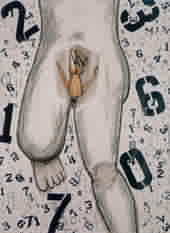
Before the Crash, 1987
Philip Tsiaras works as a painter, sculptor, and photographer in equal measure. He was born in 1952 in Nashua, New Hampshire. His mother is from northern Thessaly; his father, who is from Macedonia, became a hair stylist after immigrating, but eventually achieved a successful career selling real estate. Tsiaras attended Amherst College, graduating in 1975, and after winning a prestigious award for his own poetry, he traveled to Greece on a fellowship in 1976 to translate modern Greek poetry into English. At the same time, he also became interested in photography, a field that he pursued when he returned to the United States and relocated to Manhattan. Meanwhile, he was looking for a way to combine his writing with painting. "I started doing a series of drawings where I would make drawings out of handwriting without line, just handwriting. As the series got more involved, the writing became more calligraphic, more open, larger, more graphic and by the end more unreadable. It wasn't necessary to read anything because I was now painting poems."
During the 1980s, Tsiaras embarked on two important series: Night Drawings and Liquid Portraits-half drawing, half painting on paper. He has described the Liquid Portraits as "animated psychological 'others'"; he collects masks and likes "the idea of being able to tear away an identity only to find another probable mask." In the mid-1980s, Tsiaras turned toward ceramics, creating wildly imaginative "baroque" vases.
Tsiaras's work in all mediums is characterized by deliberate excess and a fascination with the relationship of sensual fantasy to the banality of socialized behavior. His Deified bull (1981) is a ceramic trophy in which the bull, symbol of both raw masculine power and of Wall Street's bull market, has lost one horn. Insofar as the financial world is a channel for male sexual fulfillment, the symbolic emasculation of the bull represents the overlap of mythical notions of sexuality with the prosaic realities of contemporary life. In his Family Album Photographs (1980-90), a series of dramatically staged photographs taken with family members in the family home, Tsiaras juxtaposes the sensuality of his own youthful body with the cluttered bric-a-brac of a typical middle-class Greek home, complete with reproductions of the Discus Thrower and other Greek paraphernalia.
Self consciously narcissistic, Tsiaras inserts his body into scenes of haircuts, art classes (he is the model), and presentations of Greek military gear. Aware of the eye of the camera, he acknowledges his body's physical electricity. Oblivious, his parents and aunts live in the fantasy world of their own creation in which sensuality is canned in the form of kitsch decoration.